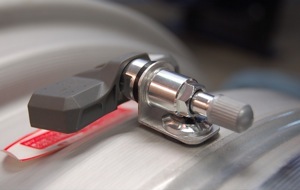|
Other Energy Options Sought as the End of TPMS Battery Life Nears First generation TPMS sensors are nearing the end of their battery life, so it's a perfect time to take a look at the new technologies being developed to increase TPMS sensor service life without compromising performance.
Direct TPMS is currently the most accurate method of obtaining tire pressures during vehicle operation. Compared to indirect systems, the in-wheel tire pressure sensor has a higher degree of sensitivity to pressure changes, allowing accurate feedback to the driver. Still in its infancy, TPMS technology continually evolves as a variety of manufacturers vie for part of a global market projected to reach $3 billion by 2017. Part of this will be driven by Europe, as mandatory TPMS comes on-stream there in the not too distant future. And wait until China, with its massive car parc, goes to mandatory TPMS. As we have previously discussed, first generation TPMS sensors are nearing the end of their battery life, so it's a perfect time to take a look at the new technologies being developed to increase TPMS sensor service life without compromising performance. Some of these might even serve to improve performance. Current TPMS technology utilizes either 3-volt lithium ion or 1.25-volt nickel metal-hydride batteries to energize the sensors. Sensors generally transmit pressure data to the on-board computer every few minutes so as to maximize battery life, but this low sampling rate could be detrimental in a rapid air-loss situation. Sensors also go into "sleep mode" when the vehicle is parked to minimize energy loss, and re-awaken after the vehicle has been driven for a few miles. It is possible after vehicle startup that a low-pressure situation will not be apparent until several miles down the road. It seems the ideal direct TPMS sensor would have a lifetime energy supply and provide a higher frequency sampling rate. Having to never worry about battery failure certainly would be an acceptable feature from the consumer's point of view. And high frequency sampling rates currently exist in the racing world. For racing applications, Beru manufactures TPMS sensors that also measure internal tire temperatures using infra-red technology at a sampling rate of 1 cycle per second, but that is one end of the extreme spectrum where cost and battery life are of no real concern. To have a continuous supply of electrical power, the TPMS industry is turning to energy harvesters for a practical solution. Energy Options PZT (lead zirconium titanate), a man-made ceramic compound, appearsto be the most popular choice as an energy harvesting material. When subjected to vibration or deformation, PZT creates a relatively high-energy output. But wait there's that toxic word, lead, trying to find its way back into the tire/wheel assembly. Fortunately, there has been a resurganceto develop lead-free piezoelectric materials because of the toxicity concerns of lead-containing devices. Having a constant energy supply would allow for higher sampling rates, and rather than waiting five minutes between pressure data readings, there would be enough power to transmit pressure readings every minute or so. Used in conjunction with a capacitor to store electrical energy, instantaneous pressure data transmission upon vehicle startup could be realized, eliminating the built-in inoperative feature currently in use. The success of piezoelectric materials will depend on finding a low-cost method of mass production to make them attractive as a replacement for traditional batteries. Most vehicle manufacturers are cost sensitive, and I believe they will determine when the industry will change over to piezoelectric power. Practical Concerns It would be more advantageous to have the pressure sensor attached to the tire profile, preferably during the manufacturing process, so as to make it an integral part of the tire. Unfortunately, the inherent brittleness of ceramic in PZT does not lend itself to this application. Advanced Cerametricsin Lambertville, N.J., has created a patented viscous suspension spinning process (VSSP) that transforms any ceramic material into a fiber form, giving it a degree of flexibility. This technology would give materials like PZT the robustness necessary for application to the tire's inside surface. Along a similar design application, U.K.-based Piezotag Ltd. has successfully developed a piezoelectric-powered TPMS sensor that mounts on the inside of the tire. The disc-like device is bonded to the tire innerliner and requires no battery for power or initiators in the wheel well for tire position identification. The housing of the sensor was designed to protect the delicate nature of the piezo ceramic, and product testing has shown positive results for durability throughout the life of the tire. The current drawback is the labor involved in mounting the sensor as compared to the current method of snap-in or clamp-in sensors at the valve hole. Again, the OEMs will shape the future of this TPMS sensor option. Automotive sensors have been around for decades to monitor a variety of vehicle systems such as engine oil pressure, cooling system temperature and fuel level. It is ironic that the most critical component of a vehicle that has greatest impact on vehicle safety - its tires - has become one of the last to incorporate sensors and the one with the greatest push-back by so many in the industry. To complicate matters, such a safety-critical system was designed to rely on batteries, and everyone involved knew the day would come when the batteries would run dry, creating inoperative system and flummoxed drivers. A true tire safety system needs to have maximum reliability throughout the vehicle's service life. The current battery technology defeats the purpose of this safety system, but new technology is around the corner to make TPMS the safety system its creators envisioned. If only we could get automaker buy-in. Source: Tire Review - Rudy Consolacion |
